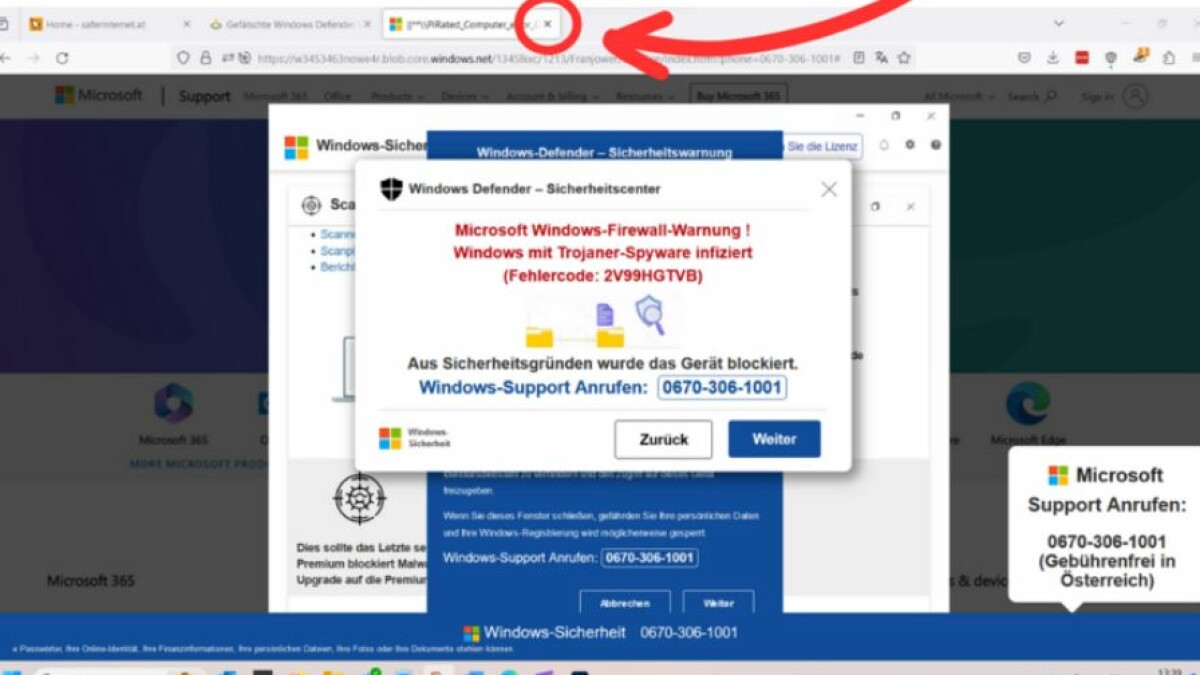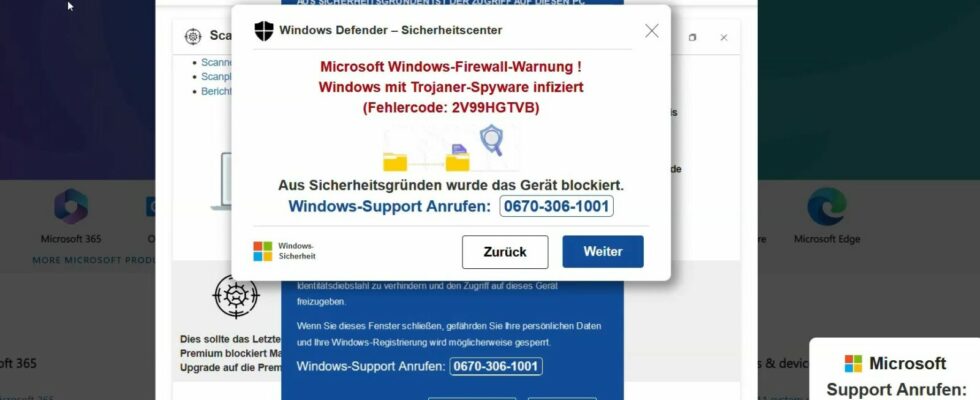A consumer protection portal warns of false Microsoft security warnings. The goal is to steal your data. If you are affected, you can still prevent this.
It looks real, but it is fake: If you see this safety warning, do not follow the instructions given. (Source: Watchlist Internet / Austrian Institute for Applied Telecommunications)
- False Microsoft security warnings are circulating.
- These ask you to call a phone number that will direct you to criminals.
- However, those affected can remove the fake warning beforehand using various tricks.
Attention Windows users! Fraudsters are currently trying to get your data with security warnings from Microsoft that look convincingly real. Do you read the message: “For security reasons, the device has been blocked. Call Windows Support”, so don’t do that under any circumstances. The consumer protection portal Watchlist Internet warns of the scam.
In the picture above you can see how the false security warning comes along. To scare you further, the fake message is accompanied by a computer voice. They want you to believe that your data is being passed on to hackers. To top it all off, they threaten to lock your computer if you close the window.
That’s why the scam is so dangerous
You can supposedly get help via a hotline, but you will only end up with criminals who will probably ask you to install dubious programs on your PC, according to Watchlist Internet. In the worst case, Trojans, spyware or other malware can get onto your computer.
Microsoft security alert: what should I do?
If you have also become a victim of the scam, stay calm. Contrary to what the security report says, nothing has happened to your data up to this point. However, closing the security warning is more difficult than it initially seems. If you try to close it using the “x” at the top right of the security window, the warning will be displayed in full screen.
The reason: It is not a security window, but a website that is only intended to give the appropriate impression. However, you can close the full screen again using the Esc key (top left of the keyboard). To really get rid of the fake warning, click on the “x” at the top of your browser’s tab bar, as shown here in a screenshot from Watchlist Internet:

To remove the fake warning, you have to click on the “x” in the browser tab bar. (Source: Watchlist Internet / Austrian Institute for Applied Telecommunications)
If that doesn’t work, the consumer protection portal advises that you should close the entire browser (click on the “x” in the top right of the browser or right-click on the browser window in the footer and then select “Close all windows”). If that doesn’t work, shut down your computer with your browser open. When you restart, the message should disappear.
Simple signs: How to recognize every phishing email
A first indication that you have received a phishing email: The email will ask you to confirm personal information or enter it on a website. This Under no circumstances should you comply with the demand. In addition, criminals often use the official logos of the companies they are copying in their emails, but not official sender addresses.
If the sender seems suspicious to you, you should read the email twice. You will often find spelling errors or inconsistencies in German grammar. The attackers usually do not write their own emails, but instead use automatically generated messages or translate known emails with a translation program. But why actually go to all this effort?
What do criminals achieve with phishing attacks?
Phishing is used on the Internet to collect real user data. These can be used to make money when email addresses, names and other information are sold for advertising purposes or passed on in criminal forums. With the data obtained, cyber criminals can also target future phishing attacks more specifically, making their attacks more effective.
Have you received a suspicious email?
Forward it to [email protected]
or follow us on:
Phishing checklist
- ✔
Spelling mistake? - ✔
Sensitive data requested? - ✔
Official logos? - ✔
Unknown sender?
Attachments and links contained in malicious emails often introduce malware or viruses to your computer. In addition, you should not simply ignore suspicious emails. Forward it to the email address above and help us report future phishing attacks.
More fraud warnings on netzwelt – stay one step ahead of cybercriminals
But phishing emails are not the only danger lurking on the Internet. In addition to attempted fraud, there are all sorts of viruses, Trojans and malware that can infect your computer. Unfortunately, data scandals are also part of everyday digital life. You can see the five most recent articles on the topic of “fraud warnings” below:
If you want to stay informed about the latest fraud reports, subscribe to netzwelt on Twitter, Facebook and Instagram. You can also find all articles on the topic on the next page.
- ” Tip: The best VPN providers for more security and data protection
- » Buy balcony power plant: Comparison of the best solar systems
Don’t miss anything with this NETWORK WORLDNewsletter
Every Friday: The most informative and entertaining summary from the world of technology!
